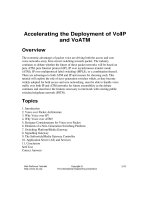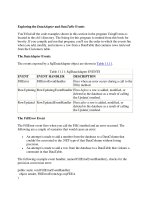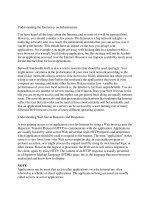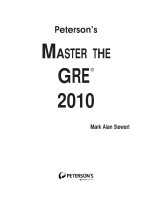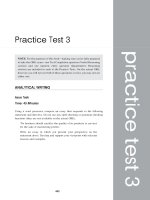Tài liệu PHP: The Good Parts: Delivering the Best of PHP- P8 docx
Bạn đang xem bản rút gọn của tài liệu. Xem và tải ngay bản đầy đủ của tài liệu tại đây (544.21 KB, 20 trang )
The PHP documentation points out that closures are also great for use in callback
functions when you are walking through an array (for example) and you want to run
a function against each element of an array. Here is a very simple example:
$person_info = function($value, $key)
{
echo $key . ": " . $value . "<br/>";
};
$person_array = array('name' => 'Dawn', 'age' => '15', 'eyecolor' => 'green');
array_walk($person_array, $person_info);
Here, we pass an actual variable to the array_walk function as its second parameter,
rather than as a true reference to a function.
NOWDOC
The next 5.3 enhancement I’d like to bring to your attention is called NOWDOC,
which is merely a variation on the HEREDOC functionality in relation to string man-
agement. If you recall, HEREDOC text behaves the same as if you were working with
a string within double quotes, in that it allows for the inclusion of variable content
directly within the string such that the content of the variable will be resolved within
the string. The NOWDOC construct behaves the same as if you were dealing with
strings in single quotes, in that there is no resolution of variable content (no interpo-
lation), as the token is defined with single quotes. Here is an example of HEREDOC
and NOWDOC to contrast what each does:
$myname = "Peter MacIntyre" ;
$str = <<<"HEREDOC_Example"
Lorem ipsum dolor sit amet,
nibh euismod tincidunt $myname .
HEREDOC_Example;
echo $str ;
$str2 = <<<'NOWDOC_Example'
Lorem ipsum dolor sit amet,
nibh euismod tincidunt $myname .
NOWDOC_Example;
echo "<br/>" . $str2 ;
And here is the expected browser output:
Lorem ipsum dolor sit amet, nibh euismod tincidunt Peter MacIntyre.
Lorem ipsum dolor sit amet, nibh euismod tincidunt $myname.
NOWDOC | 123
Please purchase PDF Split-Merge on www.verypdf.com to remove this watermark.
The NOWDOC construct lends itself to longer segments of text that don’t require any
character or variable escaping, like the body of a standard email message or some dis-
claimer text on a report.
goto Operator
If you have ever used a language like Basic or Visual Basic, you know all about
the goto statement in those languages. There was reportedly a great struggle within the
PHP development team when discussing whether they should add this feature to the
language, and it looks like the advocates won out. This operator allows you to jump to
other locations within a code file. This is a powerful new addition to the language,
which is why I am introducing it here. But, as you will see in the following examples,
it can also be considered a “bad part” of PHP if used improperly. There is a section on
the goto statement in the Appendix for this reason.
There are some limitations on goto’s use:
• You cannot jump to another code file.
• You cannot jump out of or into a function or method (you can only jump within
the same scope).
• You cannot jump into looping structures like while loops or switch constructs, but
you can jump out of them.
To define a goto destination, mark it with a label (which can be alphanumeric, but must
start with an alpha character) followed by a colon (:). To activate the jumping action,
simply precede the label name with the goto command. Here is a simple example:
$letter = "A" ;
if ($letter == "A") {
goto landing_area_a;
} else {
goto landing_area_b;
}
landing_area_a:
echo 'The Eagle has landed<br/>';
landing_area_b:
echo 'The Hawk has landed<br/>';
The browser output may not be quite what you expect:
The Eagle has landed
The Hawk has landed
The reason that both of these comments are sent to the browser is that once you reach
your goto destination, the code continues from that point and runs forward, so the next
label (landing_area_b:) is ignored, but the echo statement is executed, as it is next in
124 | Chapter 10: PHP 5.3 Good Parts
Please purchase PDF Split-Merge on www.verypdf.com to remove this watermark.
line. A way around this is to add another goto statement that will effectively jump over
the remaining code that you don’t want to run.
landing_area_a:
echo 'The Eagle has landed<br/>';
goto lands_end;
landing_area_b:
echo 'The Hawk has landed<br/>';
lands_end:
Of course, you are starting to see exactly why there was so much discussion about
whether or not to add this feature into PHP 5.3. There is the potential to write what is
known as spaghetti code, code that potentially jumps and lands all over the file and that
makes it frightfully difficult to follow and maintain.
One further warning is the potential for endless looping. Take a look at this code and
try to follow it; I don’t recommend that you load it into your PHP environment unless
you have the ability to shut it down on your own:
starting_point:
$letter = "A" ;
if ($letter == "A") {
goto landing_area_a;
} else {
goto landing_area_b;
}
landing_area_a:
echo 'The Eagle has landed<br/>';
goto lands_end;
landing_area_b:
echo 'The Hawk has landed<br/>';
lands_end:
goto starting_point;
Here are the first few lines of the browser output:
The Eagle has landed
The Eagle has landed
The Eagle has landed
The Eagle has landed
The Eagle has landed
The Eagle has landed
As you can see, this is the dreaded endless loop, which the goto operator can create if
you are not careful. If this happens to you and you are quick enough on the mouse,
you should be able to stop the browser page before it overloads your web server.
goto Operator | 125
Please purchase PDF Split-Merge on www.verypdf.com to remove this watermark.
Whatever you do, try not to write these two lines of code (I have actually
seen an inept programmer write code exactly like this a few years back
in a mainframe language):
landing15:
goto landing15;
It is the tightest possible goto loop, and the hardest one to locate! At
least in this instance, PHP gives you all the rope you need and it’s up to
you not to hang yourself. You have been warned!
DateTime and DateTimeZone Classes
PHP developers should be well aware of the date and time functions that are available
for performing date-related tasks like adding a date stamp to a database record entry
or calculating the difference between two dates. Since version 5.2, PHP has provided a
DateTime class that can handle much more date and time information at the same time,
rather than working with a plethora of separate date and time functions. Also, it works
hand-in-hand with the new DateTimeZone class. We are looking at this class here in this
chapter because it is a relatively new addition to PHP even though it is not strictly a
new 5.3 feature set.
Timezone management has become more prominent in recent years with the onset of
web portals and social web communities like Facebook and MySpace. Posting infor-
mation to a website and having it recognize where you are in the world in relation to
others on the same site is definitely a requirement these days. However, keep in mind
that a function like date() will take the default information from the server on which
the script is running, so unless the human client tells the server where she is in the
world, it can be quite difficult to determine timezone location automatically.
There are a total of four interrelated classes that have to do with dates and times; we
will look at three of them in this discussion. The constructor of the DateTime class is
naturally where it all starts. This method takes two parameters: the timestamp and the
timezone. Here is the syntax of a typical constructor method:
$dt = new DateTime("2010-02-12 16:42:33", new DateTimeZone('America/Halifax'));
This creates the $dt object and assigns it a date and time string with the first parameter
and sets the timezone with the second parameter. The second parameter instantiates a
new DateTimeZone object initially, then passes it through as the second parameter to the
constructor. You can alternately instantiate the DateTimeZone object into its own vari-
able and then use it in the DateTime constructor, like so:
$dtz = new DateTimeZone('America/Halifax') ;
$dt = new DateTime("2010-02-12 16:42:33", $dtz);
Obviously, we are assigning hardcoded values to these classes, and this type of infor-
mation may not always be available to your code, or it may not be what you want. We
can pick up the value of the timezone from the server’s .ini file and use it inside the
126 | Chapter 10: PHP 5.3 Good Parts
Please purchase PDF Split-Merge on www.verypdf.com to remove this watermark.
DateTimeZone class. To pick up the current server value from the .ini file, use code similar
to the following:
$timeZone = ini_get('date.timezone') ;
$dtz = new DateTimeZone($timeZone) ;
$dt = new DateTime("2010-02-12 16:42:33", $dtz);
Each of the code examples above merely establish a set of values for two classes,
DateTime and DateTimeZone. Eventually, you will be using that information in some way
elsewhere in your script. One of the methods of the DateTime class is called format, and
it uses the same formatting output codes as the date function does. Those date format
codes are all listed in Table 10-1. Here is a sample of the format method being sent to
the browser as output:
echo "date: " . $dt->format("Y-m-d h:i:s");
The browser then shows the following output:
date: 2010-02-12 04:42:33
Table 10-1. Format characters for the DateTime class
Format character Description
Day
d Day of the month, two digits with leading zeros [01 to 31]
D A textual representation of a day, three letters [Mon through Sun]
j Day of the month without leading zeros [1 to 31]
l (lowercase L) A full textual representation of the day of the week [Sunday through Saturday]
N ISO-8601 numeric representation of the day of the week (added in PHP 5.1.0) [1 (for
Monday) through 7 (for Sunday)]
S English ordinal suffix for the day of the month, two characters [st, nd, rd or th; works well
with j]
Week
w Numeric representation of the day of the week [0 (for Sunday) through 6 (for Saturday)]
z The day of the year (starting from 0) [0 through 365]
W ISO-8601 week number of year, weeks starting on Monday (added in PHP 4.1.0) [Example:
42 (the 42nd week in the year)]
Month
F A full textual representation of a month, such as January or March [January through
December]
m Numeric representation of a month, with leading zeros [01 through 12]
M A short textual representation of a month, three letters [Jan through Dec]
n Numeric representation of a month, without leading zeros [1 through 12]
t Number of days in the given month [28 through 31]
DateTime and DateTimeZone Classes | 127
Please purchase PDF Split-Merge on www.verypdf.com to remove this watermark.
Year
L Whether it’s a leap year [1 if it is a leap year, 0 otherwise]
o ISO-8601 year number; this has the same value as Y, except that if the ISO week number
(W) belongs to the previous or next year, that year is used instead (added in PHP 5.1.0)
[Examples: 1999 or 2003]
Y A full numeric representation of a year, four digits [Examples: 1999 or 2003]
y A two-digit representation of a year [Examples: 99 or 03]
Time
a Lowercase Ante Meridiem and Post Meridiem [am or pm]
A Uppercase Ante Meridiem and Post Meridiem [AM or PM]
B Swatch Internet time [000 through 999]
g 12-hour format of an hour without leading zeros [1 through 12]
G 24-hour format of an hour without leading zeros [0 through 23]
h 12-hour format of an hour with leading zeros [01 through 12]
H 24-hour format of an hour with leading zeros [00 through 23]
i Minutes with leading zeros [00 to 59]
s Seconds with leading zeros [00 through 59]
u Microseconds (added in PHP 5.2.2) [Example: 654321]
Timezone
e Timezone identifier (added in PHP 5.1.0) [Examples: UTC, GMT, Atlantic/Azores]
I (capital i) Whether or not the date is in daylight savings time [1 if daylight savings time, 0 otherwise]
O Difference from Greenwich mean time (GMT) in hours [Example: +0200]
P Difference from GMT with colon between hours and minutes (added in PHP 5.1.3)
[Example: +02:00]
T Timezone abbreviation [Examples: EST, MDT]
Z Timezone offset in seconds; the offset for timezones west of UTC is always negative, and
for those east of UTC is always positive [-43200 through 50400]
Full date/time
c ISO-8601 date (added in PHP 5) [2004-02-12T15:19:21+00:00]
r RFC 2822 formatted date [Example: Thu, 21 Dec 2000 16:01:07 +0200]
U Seconds since the Unix Epoch (January 1 1970 00:00:00 GMT) [See also time()]
So far, we have provided the date and time to the constructor, but sometimes you will
also want to pick up the date and time values from the server; to do this, simply provide
the string “now” as the first parameter. The following code does the same as the other
examples, except that it gets the date and time class values from the server; in fact, since
it gets the information from the server, the class is much more fully populated:
128 | Chapter 10: PHP 5.3 Good Parts
Please purchase PDF Split-Merge on www.verypdf.com to remove this watermark.
$timeZone = ini_get('date.timezone') ;
$dtz = new DateTimeZone($timeZone) ;
$dt = new DateTime("now", $dtz);
echo "date: " . $dt->format("Y-m-d h:i:s");
The browser output shows the value from the server:
date: 2010-02-18 12:38:14
The DateTime diff
method acts as you would expect; it returns the value of the differ-
ence between two dates. The catch here is that the result of the diff method is to
instantiate and populate the DateInterval class. This class also has a format method,
but because it deals with the difference between two dates, the format character codes
are different. They are provided in Table 10-2.
Table 10-2. Format characters for the DateInterval class
Character description
Each format character must be preceded by a
percent (%) sign Format
% Literal %
Y Years, numeric, at least two digits with leading 0 [01, 03]
y Years, numeric [1, 3]
M Months, numeric, at least 2 digits with leading 0 [01, 03, 12]
m Months, numeric [1, 3, 12]
D Days, numeric, at least 2 digits with leading 0 [01, 03, 31]
d Days, numeric [1, 3, 31]
a Total amount of days [4, 18, 8123]
H Hours, numeric, at least 2 digits with leading 0 [01, 03, 23]
h Hours, numeric [1, 3, 23]
I Minutes, numeric, at least 2 digits with leading 0 [01, 03, 59]
i Minutes, numeric [1, 3, 59]
S Seconds, numeric, at least 2 digits with leading 0 [01, 03, 57]
s Seconds, numeric [1, 3, 57]
R Sign “−” when negative, “+” when positive [−, +]
r Sign “−” when negative, empty when positive [−, ]
So, to get the difference between two dates (two DateTime
objects, more accurately),
we write code like this:
$timeZone = ini_get('date.timezone') ;
$dtz = new DateTimeZone($timeZone) ;
DateTime and DateTimeZone Classes | 129
Please purchase PDF Split-Merge on www.verypdf.com to remove this watermark.
$start_dt = new DateTime("2009-02-12 16:42:33", $dtz);
$dt = new DateTime("now", $dtz);
// creates a new instance of TimeInterval
$dt_diff = $start_dt->diff($dt) ;
echo "<br/><br/>The difference between: " . $start_dt->format("Y-m-d")
. " and " . $dt->format("Y-m-d") . " is"
. $dt_diff->format('%y year, %m months, and %d days');
The diff
method is called on one of the DateTime objects with the object of the other
DateTime being passed in as a parameter. Then we prepare the browser output with the
format method call.
Let’s look a little more closely at the DateTimeZone class now. You can lift the timezone
setting out of the php.ini file with the get_ini function that we have already seen. You
can gather more information out of that timezone with the getLocation method. It
provides the country of origin of the timezone, the longitude and the latitude, plus some
comments. With these few lines of code, you have the beginnings of a web GPS system:
$timeZone = ini_get('date.timezone') ;
$dtz = new DateTimeZone($timeZone) ;
echo "Server's Time Zone: " . $timeZone . "<br/>";
foreach ( $dtz->getLocation() As $key => $value ){
echo $key . " " . $value . "<br/>";
}
This produces the following browser output:
Server’s Time Zone: America/Halifax
country_code CA
latitude 44.65
longitude −62.4
comments Atlantic Time - Nova Scotia (most places), PEI
If you want to set a timezone that is different from the server, pass that value to the
constructor of the object. Here, we set the timezone for Rome, Italy, and display the
information with the getLocation method. Notice that we pick up the set timezone
with the getName method (even though we manually set it on the previous line of code):
$dtz = new DateTimeZone("Europe/Rome") ;
echo "Time Zone: " . $dtz->getName() . "<br/>";
foreach ( $dtz->getLocation() As $key => $value ){
echo $key . " " . $value . "<br/>";
}
130 | Chapter 10: PHP 5.3 Good Parts
Please purchase PDF Split-Merge on www.verypdf.com to remove this watermark.

